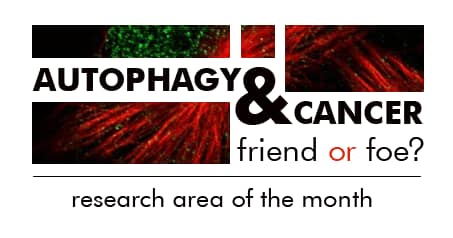
Research of the Month – June 2014 Autophagy and Cancer: Friend or Foe? Autophagy is a basic catabolic process that involves cell degradation of unnecessary or dysfunctional cellular components through lysosomes. The process consists of sequential stages, including initiation, elongation, maturation and degradation, which are regulated by a series of highly conserved autophagy related genes (Atgs) involved in various signaling pathways. Autophagy contributes to the pathogenesis of diverse diseases such as neurodegeneration and cancer. In cancer initiation and development autophagy plays a dual role: on one hand, autophagy eliminates senescent and injured cells and suppresses tumor initiation. Autophagy deficiency by the deletion of Atgs in mice causes a high incidence of spontaneous tumors. On the other hand, autophagy provides energy to maintain energy balance by recycling damaged organelles, DNA, aggregated proteins and pathogens, which promotes cancer cell survival. While the functional relevance of autophagy in cancer remains controversial, Novus Biologicals devotes to providing high quality antibodies for the Autophagy research community to solve the scientific puzzle, explore the discoveries and advance autophagy research into its clinical applications. |
|||||||||||||||||||||||||||||||||||||||||||||||||||||||||||||||
|
Table 1. Major autophagy related targets |
|||||||||||||||||||||||||||||||||||||||||||||||||||||||||||||||
|
|||||||||||||||||||||||||||||||||||||||||||||||||||||||||||||||
|
Table 2. Major Regulators of Autophagy
|
|||||||||||||||||||||||||||||||||||||||||||||||||||||||||||||||
Here we also highlight the following proteins in the core machinery of autophagosome formation that we’re offering to help and speed up your investigations on the puzzle between Autophagy and Cancer. |
|||||||||||||||||||||||||||||||||||||||||||||||||||||||||||||||
|
|||||||||||||||||||||||||||||||||||||||||||||||||||||||||||||||